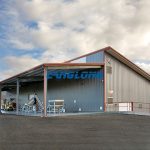Comparison of steel warehouse buildings in different countries
In the context of globalization, steel warehouse buildings, as an important part of the modern logistics system, have shown their own unique design styles and practical functions in different countries and regions. By comparing and analyzing steel warehouse building from an international perspective, we can draw valuable experience from them and provide useful reference for the development of steel structure warehouse.

1. Differences in design concepts
In European and American countries, the design of steel warehouse buildings often focuses on the combination of practicality and aesthetics. Designers tend to adopt large-span and large-bay steel structures to meet the needs of modern warehousing for spatial flexibility. At the same time, these buildings pursue simplicity without losing their modernity in appearance design, and often use large areas of glass curtain walls or metal plates, which not only ensures indoor lighting and ventilation, but also shows the industrial beauty of the building.
In Asia, especially in countries such as China and Japan, the design of steel warehouse building pays more attention to economy and practicality. These buildings often use standardized components and modular combinations to reduce construction costs and improve construction efficiency. At the same time, considering the climatic characteristics of Asia, designers will also work hard on the insulation, heat insulation, and waterproofing of the building to ensure the long-term performance of the building.

2. Innovation of building materials
In the field of international steel warehouse construction, the innovation of building materials has always been an important driving force for the development of the industry. European and American countries are in a leading position in the research and development and application of building materials. They have developed a series of high-performance steel and connectors, which have significantly improved the bearing capacity and seismic performance of steel warehouse buildings.
In Asia, especially China, remarkable results have been achieved in the innovation of building materials in recent years. For example, some companies have developed high-strength steel and anti-corrosion coatings with independent intellectual property rights. These materials not only improve the bearing capacity of steel structure warehouse, but also extend the service life of buildings.

3. Application of intelligent technology
With the continuous development of intelligent technology, international steel warehouse buildings have made significant progress in intelligence. Steel warehouse building in European and American countries generally adopt advanced automated warehousing systems and intelligent logistics management systems, which can achieve accurate positioning, rapid sorting and efficient distribution of goods, greatly improving warehousing efficiency.
In Asia, especially China, significant breakthroughs have been made in the application of intelligent technology in recent years. Some steel warehouse buildings have begun to adopt intelligent security systems, environmental monitoring systems and energy management systems, which can monitor the safety status, environmental parameters and energy consumption of buildings in real time, providing strong data support for the operation and maintenance of buildings.

4. Reference and inspiration
By comparing and analyzing steel warehouse buildings from an international perspective, we can draw the following references and inspirations:
- Focus on the combination of practicality and aesthetics: In the design of steel structure warehouse, practicality and aesthetics should be taken into account to meet the needs of modern warehousing for spatial flexibility and architectural beauty.
- Promote the innovation of building materials: Increase the research and development of building materials, improve the performance and durability of steel, reduce construction costs and improve construction efficiency.
- Strengthen the application of intelligent technology: Actively introduce and apply intelligent technology, improve storage efficiency and building management level, and provide strong support for the sustainable development of steel warehouse buildings.











